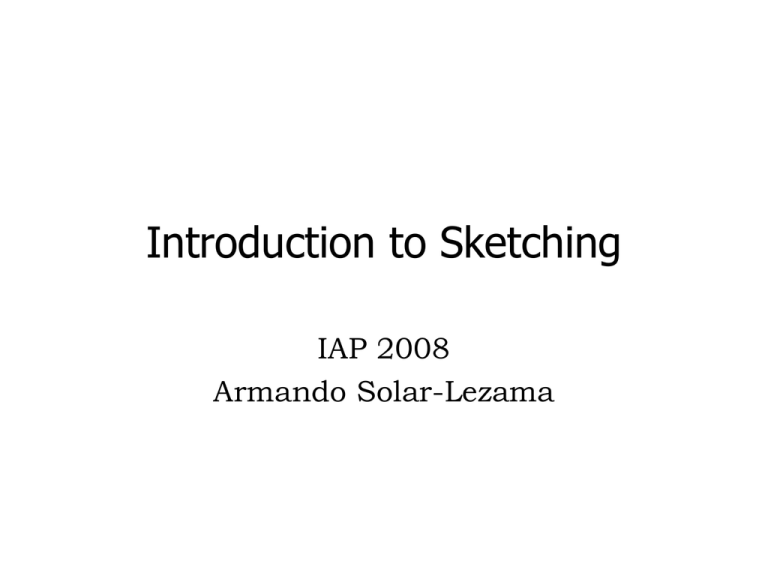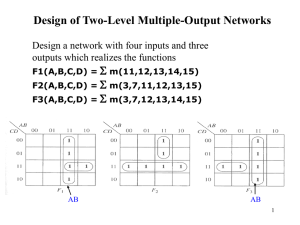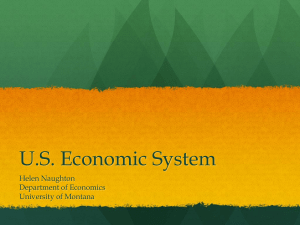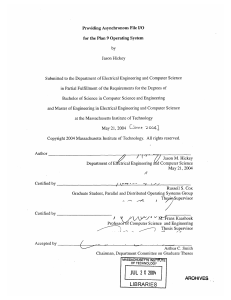PPT - People.csail.mit.edu
advertisement

Introduction to Sketching
IAP 2008
Armando Solar-Lezama
Experience with homework
Step 1: Turn holes into special inputs
◦ The ?? Operator is modeled as a special input
- we call them control inputs
bit[W] isolSk(bit[W] x)
{
return ~(x + ??) & (x + ??);
}
bit[W] isolSk(bit[W] x, bit[W] c1, c2)
{
return ~(x + c1) & (x + c2);
}
◦ Bounded candidate spaces are important
- bounded unrolling of repeat is important
- bounded inlining of generators is important
Step 2: Constraining the set of controls
◦ Correct control
- causes the spec & sketch to match for all inputs
- causes all assertions to be satisfied for all inputs
◦ Constraints are collected into a predicate
Q(in, c)
◦ -showDAG will show you the constraints!
int popSketched (bit[W] x)
implements pop {
loop (??) {
x = (x & ??)
+ ((x >> ??) & ??);
}
return x;
}
x
>>
&
&
+
mux
x
>>
&
&
+
mux
x
&
S(x,c) =
x
mux
>>
+
&
Ex : Population count.
x
int pop (bit[W] x)
{
int count = 0;
for (int i = 0; i < W;
i++) {
if (x[i]) count++;
}
return count;
}
count
0 0 0 0
one
0 0 0 1
+
mux
count
+
mux
count
+
mux
Q(in, c) = S(x,c)==F(x)
count
mux
F(x) =
count
+
A Sketch as a constraint system
Synthesis reduces to constraint satisfaction
A
c.
x. Q(x, c)
E
Constraints are too hard for standard techniques
-
Universal quantification over inputs
Too many inputs
Too many constraints
Too many holes
Insight
Sketches are not arbitrary constraint systems
- They express the high level structure of a program
A small set of inputs can fully constrain the soln
- focus on corner cases
A
c.
x
in
E. Q(x, c)
E
where E
= {x1, x2, …, xk}
This is an inductive synthesis problem !
- but how do we find the set E?
- and how do we solve the inductive synthesis problem?
Step 3:
Counterexample Guided Inductive Synthesis
Idea: Couple Inductive synthesizer with a verifier
- Verifier is charged with detecting convergence
candidate implementation
succeed
Inductive Synthesizer
◦
A E
c.
x
in
Validation
fail
Derive candidate
implementation from
concrete inputs.
ok
buggy
E.Q(x,c)
Your verifier goes here
fail
add counterexample input
observation set E
•Standard implementation uses Sat based bounded
verifier
• Any verifier/checker that produces counterexamples
works
Inductive Synthesis
Deriving a candidate from a set of observations
A
c.
Q(x,
x in
E. c)
E
where E = {x1, x2, …, xk}
Encode
c as a bit-vector
- natural encoding given the integer holes
Encode Q(xi, c) as boolean constraints on the
bit-vector
Solve constraints using SAT solver
- with lots of preprocessing in between
Controlling the SAT Solver
◦ Several options for the SAT Solver
- --synth and --verif
• ABC vs MINI (MiniSat)
- --cbits and --inbits
- --incremental
Using synthesizer feedback
◦ Results of different phases useful for debugging
- counterexample inputs
- number of iterations
◦ Some useful flags
-
--keeptmpfiles
--showInputs
--fakesolver
-checkpoint and -restore






